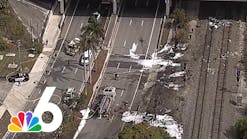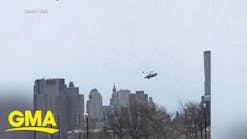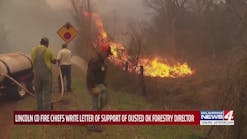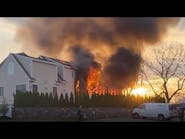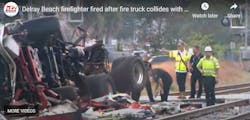Torrance, CA, Oct. 13—Torrance Fire Department (TFD) Battalion 91 arrived to a single-family dwelling with smoke and fire issuing from windows on the Alpha/Bravo corner. Engine 93’s captain performed a 360 while firefighters pulled a 1¾-inch hoseline to the front door to initiate fire attack and primary search. E93 began a transitional attack while other units made forcible entry through the front door. Truck 91 laddered the roof and cut several ventilation holes. Forty-one TFD members with the assistance of one Los Angeles County Fire Department engine took 10 minutes to knock down the fire.
Photo by Jon Androwski
New Haven, CT, Oct. 30—New Haven Fire Department Car 33 reported smoke showing from a large, one-story warehouse. The fire quickly went through the roof. Hydrants in the area were out of service. This prompted a second alarm. The delay in water and the building contents contributed to the rapid spread of the fire, including to an attached two-story warehouse, which prompted third and fourth alarms. A special call to the departments of East Haven, North Haven and West Haven brought engine companies to utilize large-diameter hose for longer lays to hydrants and relay pumping operations.
Photo by Glenn Duda
San Diego, Oct. 26—On arrival, San Diego Fire-Rescue crews found a well-involved abandoned bar, with fire venting through the roof. A second alarm was struck, and crews worked in the defensive mode. Twenty-one fire apparatus, approximately 90 firefighters, 18 command staff and support personnel, and the department’s drone team were on scene throughout the duration of the incident. It took several hours to knock down the fire because of the condition of the compromised roof. Fresh crews were rotated in throughout the next day.
Photo by Box 757 Fire Photography
Shelton, CT, June 27—The Shelton Fire Department, the Connecticut State Bomb Squad, the Bureau of Alcohol, Tobacco, Firearms and Explosives, and the state fire marshal conducted a controlled burn of a house. Officials deemed leveling the house by fire would be the safest way to mitigate the danger that was posed by many unburned and unstable fireworks that survived a fire five days earlier. Neighbors were told to shelter in place or evacuate for approximately eight hours. The residences on either side of the house were protected by water streams
and plywood.
Photo by Keith Muratori

Rich Dzierwa | Managing Editor, Firehouse Magazine
Rich Dzierwa joined Firehouse Magazine in 2019 after four tenures with other publications. He was editor-in-chief of Consumers Digest/ConsumersDigest.com and of trade magazine Cutting Tool Engineering. He served as the consumer products reporter for BridgeNews and began his publishing career with an 11-year tenure at Appliance magazine, where he rose to managing editor after serving in other roles. Dzierwa's experience with consumer products, including furnishings, appliances, electronics and space design, has transferred to his Firehouse work regarding the magazine's Station Design columns and the Station Design Awards. Previous work also has contributed to his supervision of several surveys of fire service/EMS members, to produce unique reporting for Firehouse's audience. Dzierwa earned a bachelor's degree in English from Columbia College Chicago.




